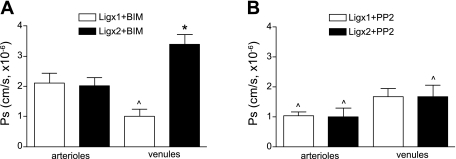Fig. 7.
ICAM-1 clustering is essential for switching from PKC-dependent to Src-dependent regulation of Ps. Unstimulated arterioles and venules were intraluminally perfused with either a mouse anti-ICAM-1 mAb (50 μg/ml iv) alone (Ligx1) or followed by rat anti-mouse secondary Ab (50 μg/ml intraluminally) (Ligx2). Ten to twenty minutes later, the tissue was superfused with either PKC inhibitor bisindolylmaleimid l (BIM; in 0.01% DMSO, 1 μM for 10 min) (A) or Src inhibitor PP2 (in 0.01% DMSO, 2 μM for 10 min) (B), and Ps was measured in selected microvessels. In arterioles, leukocyte rolling in activated conditions is mimicked by Ligx1, and this Ligx1-dependent increase in Ps is not PKC dependent (A) but is Src dependent (B). In venules, rolling in unstimulated conditions is mimicked by Ligx1, and Ps is decreased below normal by PKC block (A) and is independent of Src (B). Adhesion in activated venules is mimicked by Ligx2, and the increased Ps seen with this ligation is independent of PKC (A) and significantly decreased by Src block (B). Thus, Ps changes induced by the maximal ICAM-1 clustering achievable for each vessel type are Src dependent, whereas Ps changes induced by nonmaximal ICAM-1 clustering are PKC dependent. ^Significantly different from measurements obtained in the absence of the inhibitors (P < 0.05), as shown in Fig. 5 and previously (39). *Significantly different from Ligx1. For all groups, the measurements were made in n = 7–10 venules from 3–5 mice.

